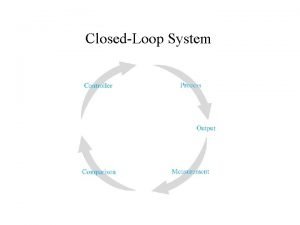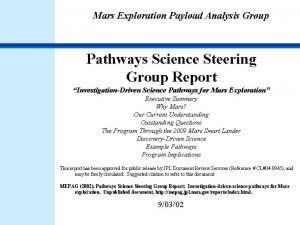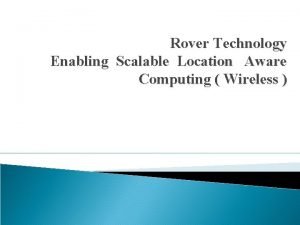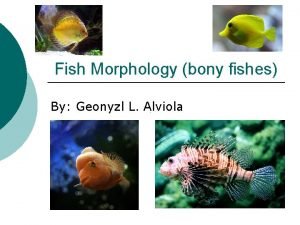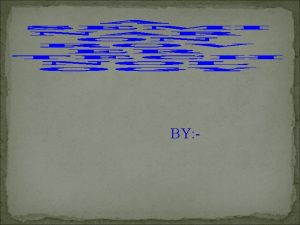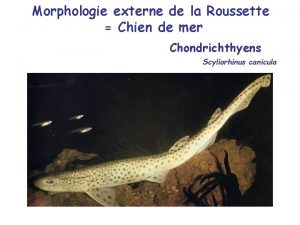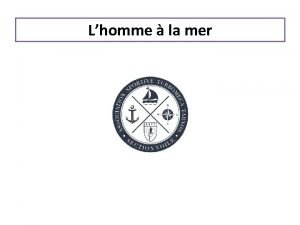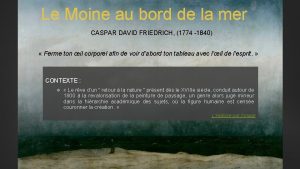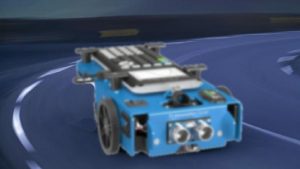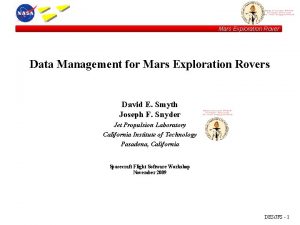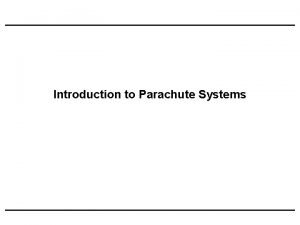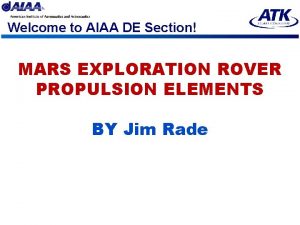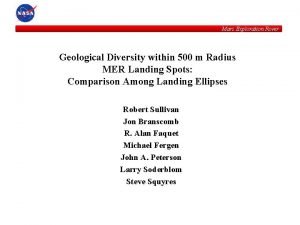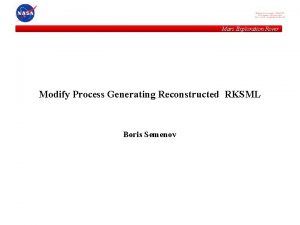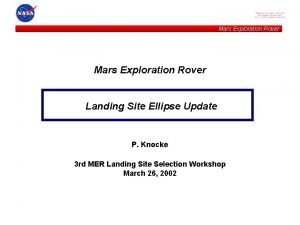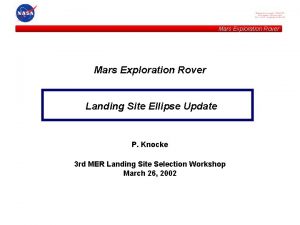Welcome Mars Exploration Rover MER Parachute Decelerator System























- Slides: 23

Welcome Mars Exploration Rover MER Parachute Decelerator System Preliminary Design Review 3 April 2001 MER PDS PDR - Document No. EA 2036 -8 ACW -

Program Objectives Mars Exploration Rover • MER Parachute Deceleration Subsystem (PDS) is to deliver the landing vehicle, in the atmosphere of Mars, to a point and flight condition where Rocket Assisted Descent and Airbag Impact Attenuation Systems can complete the descent to the surface • Resultant design should retain as much heritage as possible with previous Mars programs (MPF / MPL / MSP 01 / Viking) 3 April 2001 MER PDS PDR - Document No. EA 2036 -8 ACW - 2

Operational Sequence Mars Exploration Rover 1 1) Direct Entry from Hyperbolic Approach 2 3 2) Cruise Stage Separation: E- 15 minutes 3) Atmospheric Entry: ~125 km altitude 4 4) Parachute Deploy: ~10 km A. G. L. , ~E+ 240 s 5 5) Heatshield Jettison: 20 s after chute deploy 6 6) Bridle Descent: 20 s after heatshield jett. , 10 s to complete 7) Radar Acquisition of Ground: ~2. 4 km A. G. L 7 8) Airbag Inflate: ~4 s prior to retrorocket ignition 9) Rocket Ignition: ~160 meters A. G. L 8 10) Bridle Cut: ~15 meters A. G. L, 0 m/s vertical velocity 9 11) First Contact w/ Ground: ~E+ 360 s 10 11 3 April 2001 MER PDS PDR - Document No. EA 2036 -8 ACW -

General Design Requirements Mars Exploration Rover • Parachute Assembly – Decelerates the Entry Vehicle from supersonic flight conditions – Establishes stable vertical trajectory to permit Heat Shield jettison and Lander deployment – Provides final descent velocity and stability for Rocket Assisted Descent and Airbag Impact Attenuation Systems 3 April 2001 MER PDS PDR - Document No. EA 2036 -8 ACW - 4

General Design Requirements Mars Exploration Rover • Mortar Deployment Assembly – – – 3 April 2001 Interfaces with Backshell structure Provides deceleration parachute structural attachment points Packages and protects the Deceleration Parachute Assembly Ejects the packed parachute from the stowed configuration Accelerates parachute beyond the recirculating wake for controlled and reliable inflation MER PDS PDR - Document No. EA 2036 -8 ACW - 5

Design Requirements (Level 3) Mars Exploration Rover Requirement Assessment PDS shall ensure parachute deployment at a maximum Mach number of 2. 23 and a minimum Mach number of 1. 40. Within Viking heritage EDL shall ensure that the parachute is deployed at a dynamic pressure of at least 500 Pa and no greater than 830 Pa Determined as low risk (Workshop) PDS shall ensure that the nominal ref area (S 0) Baseline: 140% MPF chute size, of the full open parachute with suspended 1. 6 Viking Band under consideration payload is 178. 48 m 2 at Mach number 0. 3 in the Martian atmosphere PDS shall ensure parachute deployment at a maximum Angle of attack of 10 degrees. Viking, MPF, MSP 01 limit 15 degrees PDS shall tolerate a maximum payload spin rate of 4 RPM during descent. Same as MPF 3 April 2001 MER PDS PDR - Document No. EA 2036 -8 ACW - 6

Driving Level 4 Requirements Mars Exploration Rover 3 April 2001 MER PDS PDR - Document No. EA 2036 -8 ACW - 7

Parachute Inflation Dynamics Mars Exploration Rover • Parachute Inflation Force Predictions – 825 kg Vehicle / 783 Pa / Mach 1. 9 3 April 2001 11, 760 Lb Maximum 12, 365 Lb Maximum Zero Degree Angle Of Attack Initial Condition 10 Degree Angle Of Attack Initial Condition MER PDS PDR - Document No. EA 2036 -8 ACW - 8

Parachute Inflation Dynamics Mars Exploration Rover • Parachute Inflation Force Predictions – 825 kg Vehicle / 500 Pa / Mach 1. 4 10, 350 Lb Maximum 10, 622 Lb Maximum Zero Degree Angle Of Attack Initial Condition 10 Degree Angle Of Attack Initial Condition 3 April 2001 MER PDS PDR - Document No. EA 2036 -8 ACW - 9

Parachute Inflation Dynamics Mars Exploration Rover • Maximum parachute force of 12, 500 lb now used for design calculations – Additional case studies to be conducted – Need refined inertial properties for entry vehicle • Results indicate maximum parachute opening loads and subsequent transient load history influenced by initial position of Lander relative to parachute and respective placement to flight path velocity vector – Interacting inertial forces of Lander and parachute at the beginning of parachute inflation – Dynamic phenomena noted in analysis of Viking and Pathfinder systems – Effects can be minimized by stability of entry vehicle 3 April 2001 MER PDS PDR - Document No. EA 2036 -8 ACW - 10

Structural Analysis Mars Exploration Rover • Structural Design Factors – Guidance from Document NWC TP 6575 Parachute Recovery Systems Design Guide as applied to ejection seat and crew module parachutes permanently packed in well-protected containers and Pioneer experience on MPF/MPL/MSP 01 • Design Factors • Safety Factor: 1. 50 • Ultimate Design Factor: 2. 10 - 2. 49 – Definition: Margin of Safety (MS) defined as: MS = (Available Strength / Required Strength) - 1. 0 where Required Strength = Design Load x Design Factor 3 April 2001 MER PDS PDR - Document No. EA 2036 -8 ACW - 11

Structural Analysis Mars Exploration Rover • Preliminary Parachute Load Analysis 3 April 2001 MER PDS PDR - Document No. EA 2036 -8 ACW - 12

Deployment Assembly Mars Exploration Rover • Estimated MER Design Loads – Loads have increased because of increase in chute area and deployment conditions. – Preliminary Estimates: • Mortar Reaction Load: 17, 000 lb (MPF = 11, 000 lb) • Peak Inflation Load: 12, 500 lb (MPF = 7, 904 lb) (@ maximum dynamic pressure condition of 783 Pa, M = 1. 9, 825 kg entry vehicle) 3 April 2001 MER PDS PDR - Document No. EA 2036 -8 ACW - 13

Deployment Assembly Mars Exploration Rover • Mortar System - Introduction – Design Heritage • Mars Explorer Rover (MER) Mortar Deployer Subsystem (MDS) design will be based on the successful Mars Pathfinder Mortar Deployer System (MDS) developed by General Dynamics (formerly Primex/Olin) as part of the Pioneer Aerospace team – Major Requirements Summary • 100 ft/s < muzzle exit velocity < 130 ft/s (Mars) • Dual initiators for gas generator • Operational temperature range: -35 C + 10 C • Ejection mass of 34. 5 lbm (37 lbm max) • Max parachute opening load 15, 000 lbf 3 April 2001 MER PDS PDR - Document No. EA 2036 -8 ACW - 14

Deployment Assembly Mars Exploration Rover • Mortar System - Introduction (cont’d) – Principal Similarities - Pathfinder vs. MER • Same propellant, initiators and design approach • Very similar parachute deployment velocity • Development, LAT and qualification approach – Principal Differences - Pathfinder vs. MER • Deployment mass (34. 5 lbm vs. 21. 5 lbm) • Parachute volume (1620 in. 3 vs. 953 in 3) • Larger parachute inflation load (15, 000 lbf vs. 12, 000 lbf - MSP 01) 3 April 2001 MER PDS PDR - Document No. EA 2036 -8 ACW - 15

Deployment Assembly Mars Exploration Rover NSI Deployment Bag gas generator 2. 5 “ diam. increase from MPF for 40% area growth Mortar cover Not shown Bridle Mars Pathfinder PDS Shown 3 April 2001 MER PDS PDR - Document No. EA 2036 -8 ACW - 16

Deployment Assembly Mars Exploration Rover • MER Mortar Deployer Subsystem ICD 3 April 2001 MER PDS PDR - Document No. EA 2036 -8 ACW - 17

Deployment Assembly Mars Exploration Rover • Mortar Subsystem – Design – Mortar System • OD increase from 8. 4" to 10. 9" (nominal) – Gas Generator • 12 grams of WC 230 (same as previous) • Design change to improve manufacturability proposed - exterior cap configuration to improve access for burst shim braze • 2 Each NSI (CFE) – Cover (Proposed) • Same design approach – Mortar Tube • Same design approach • Will interface with Backshell Interface Plate (changes identified) • Structural evaluation will result in increased load/pressure capability for some features 3 April 2001 MER PDS PDR - Document No. EA 2036 -8 (Proposed) ACW - 18

Deployment Assembly Mars Exploration Rover Gas Generator Mortar Tube MPF shown Sabot 3 April 2001 MER PDS PDR - Document No. EA 2036 -8 Cover ACW - 19

Deployment Assembly Mars Exploration Rover • Mortar Subsystem – Earth/Mars Performance • Deployment subsystem performance will be different in Earth and Mars environments • Primary performance effects due to – Atmospheric backpressure (1 atm vs. 0. 03 atm) • Work delta = 2. 94 kj (2169 ft-lbs) • Earth environment system performance reduction offset by system operating characteristics – – Backpressure results in higher pressure under sabot Presence of air behind sabot causes higher tube delta p 3 April 2001 MER PDS PDR - Document No. EA 2036 -8 ACW - 20

Deployment Assembly Mars Exploration Rover • Mortar Subsystem – Anticipated gas generator performance – Anticipated mortar tube pressure – Anticipated reaction load Loads and velocity expected to meet requirements 3 April 2001 MER PDS PDR - Document No. EA 2036 -8 ACW - 21

Mass Properties Mars Exploration Rover • Parachute Assembly Mass Properties – Current Best Estimates, requirement 28 kg 3 April 2001 MER PDS PDR - Document No. EA 2036 -8 ACW - 22

Mortar Ejection Velocity Analysis Mars Exploration Rover MER Analysis Input Summary 3 April 2001 MER PDS PDR - Document No. EA 2036 -8 ACW - 23
 Sojourner mars rover
Sojourner mars rover Mars exploration program analysis group
Mars exploration program analysis group Mars design reference mission
Mars design reference mission What is rover technology
What is rover technology Dv-2400 video rover
Dv-2400 video rover Site:slidetodoc.com
Site:slidetodoc.com Sagittiform body shape
Sagittiform body shape Tata swot
Tata swot Long division steps
Long division steps Comedy of manners history
Comedy of manners history Rover technology
Rover technology Alexander anton
Alexander anton Melos
Melos Iron rover
Iron rover Cadillac escalade rental houston
Cadillac escalade rental houston Jlr assessment centre
Jlr assessment centre Welcome welcome this is our christmas story
Welcome welcome this is our christmas story Traversee mer rouge
Traversee mer rouge Morphologie chien
Morphologie chien Kai game history
Kai game history Manoeuvre homme à la mer
Manoeuvre homme à la mer Les toiles de mer
Les toiles de mer Le moine au bord de la mer
Le moine au bord de la mer Le romantisme introduction
Le romantisme introduction
